a. Indicate whether the following are SN−1,SN−1,E1, or E2
1. (CH3)3CBr+C2H5OH at 60∘→(CH3)3C(Major)−OC2H5+(CH3)C(Minor)=CH2
2. CH3CH2CH2Br+LiAlH4→
3. CH_(3) CH_(2) Br + Cl + I^(ᶱ) rarr
4. (CH3)3CBr+CNᶱ(Etanol)→
5. CH3CHBr−CH3+ᶱOH(H2O)→
6. CH3CHBr→CH3+ᶱOH(Ethanol)→
7. (CH3)3CBr+H2O→
b. Give teh decreasing order of reactivity of the alkaline hydrolysis of the following alkyl halides towards (1) SN−1 (2) SN2 and (3) in the presence of AgNO3:
i. (CH3)2C(Br)−C2H5 ii. C5H11Br.
iii. C2H5CH(Br)C2H5.
c. 
d. Give teh decreasing order of reactivity of alkaline hydrolysis of the followong halides towards SN−1:
1. MeCl, ii. PhCH2Cl, iii. Oh2CHCl, iv. Ph3Cl
2. 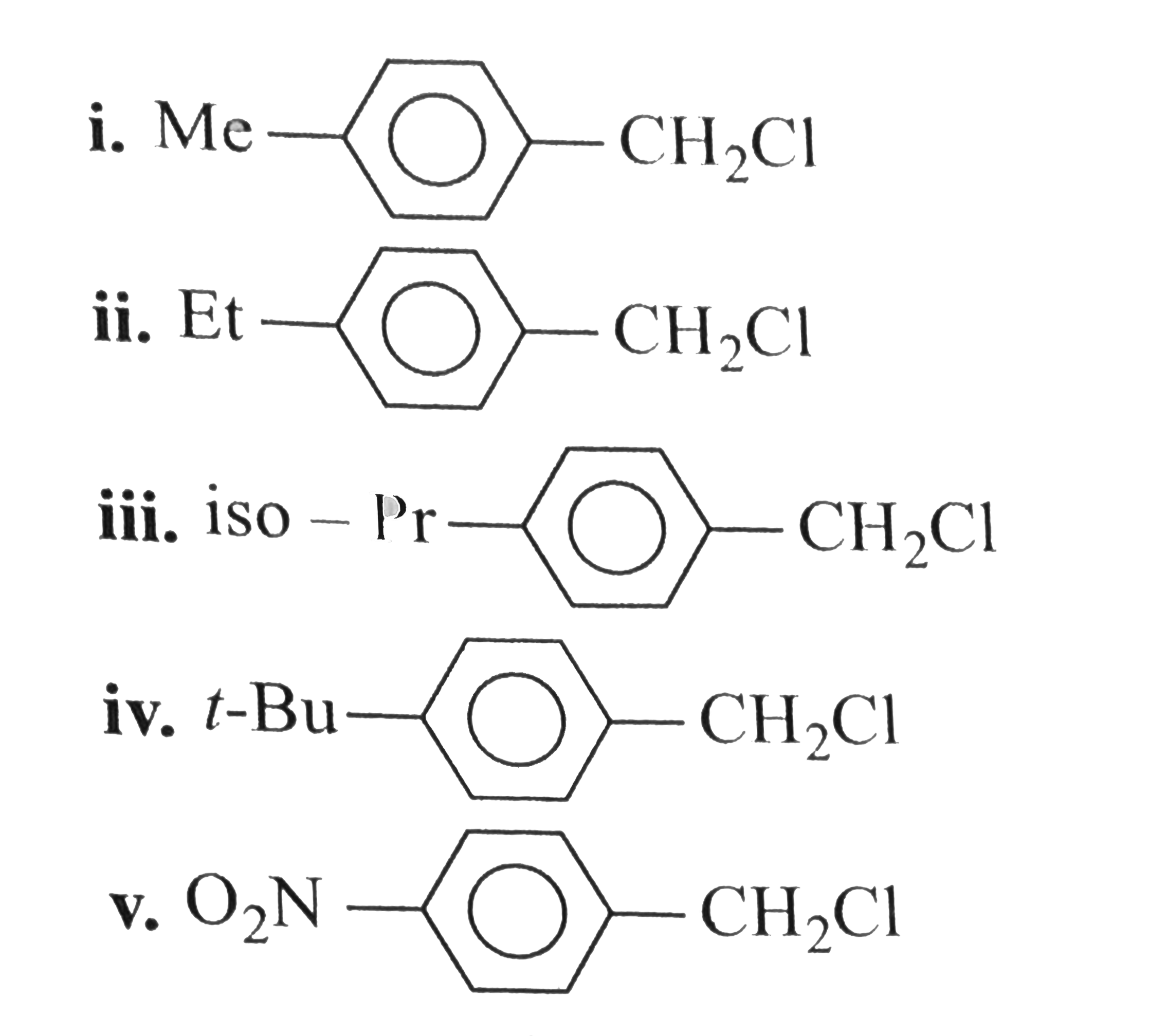
e. Determine the relative SN−2 reactivity with NaCN in aprotic DMSO of the following alkyl halides:
1. i. CH3CHClCH2CH3
ii. CH3CHBrCH2CH3
iii. CH3CHlCH2CH3
2. iv. CH3CH(CH3)CH2CH2I
v. CH3CH(CH3)CHICH3
vi. CH3CI(CH3)CH2CH3.
3. vii. 4− Bromo 1,1− dimethylcyclohexane
viii. 1− Bromo -cis or trans−1,4− dimethycyclohexane
ix. cis or trans −2− Bromo-cis−1,3− Dimethyl-cyclohexane
f. Optically pure (+)−2− bromoctane, [α]=+36∘ reacts with aq. NaOH in actone to give opstically pure (−)−2− octonal, [α]=−10.3∘. With partically racemised bromo compound whose [α]=+30∘, the [α] of alchold product is −6.0∘. Cacualte:
1. The percentage optical purity of partically racemised bromo compound and alchocol,
2. the percentaage of inversion and racemission, and
3. the percentaage of frontside and backside attack.
g. Compare teh rates of SN−1 and SN−2 reactions of:
1. Cycloprophyl and cyclopentyl chloride
2. Vinyl chloride
h. Arrange the following in the order of decresing basically:
1. Fᶱ, 2. overset(ᶱ)(O)H3.ᶱNH2, 4. CᶱH3
a. 4>3>2>1, b. 1>2>3>4,
c. 2>1>3>4, d. 3>2>1>4
i. Arrange the following in the order of decresing nuclepphillic character:
1. H2O, 2. ᶱOH, 3. CH3Oᶱ, 4. CH3COOᶱ
i. 2>3>4>1, ii. 3>2>1>4
iii. 1>4>2>3, iv. 4>1>2>3
j. Arrange the following in teh decreasing order as a leaving griup in substitution reaction.
1. CH_(3) CO overset(ᶱ),2.C_(6) H_(5)O^(ᶱ)<br>C_(6)H_(5) SO_(3)^(ᶱ),4.CH_(3)O^(ᶱ).<br>a.3gt1gt4gt2,b.3gt1gt2gt4<br>c.3gt2gt1gt4,d.4gt2gt1gt3<br>k.Theorderof≤av∈ggrouabilityforthefollow∈gis:<br>1.-OAc,2.-OMe<br>3.-OSO_(2)Me,b.4.-OSO_(2) CF_(3)<br>a.1gt2gt3gt4,b.4gt3gt1gt2<br>c.3gt2gt1gt4,d.2gt3gt4gt1
a. 1. SN−1,3∘
2. CH3CH2CH3+HBr,SN2,1⊕ ha,ode. Nuclelphile is H⊕ (hydride ion).
3. 1−CH2CH2CH3.SN2,1∘ halide, I∘ good nucleoophile and poor base.
4. (CH3)2C=CH2.E2.3∘ halide and CNᶱ is a strong base, so eleimination is presominant over SN−1.
5. CH3CHOHCH3.SN2. polar solvenet favours substitution.
6. CH2−CH=CH2.E2, less polar solvent favours E2
7. (CH3)3C−OH,SN−1,H2O is not basic enough to remove a proton to give elimation reaction.
b. 1. (i)>(iii)>(ii)(3∘>2∘>1∘ alkuyl halide) SN−1.
2. (ii)>(iii)>(i) (1∘>2∘>3∘ alkyl halide, SN2)
3. (i)>(iii)>(ii), Heavy ions, such as Ag⊕ or Pb⋅2+ catayse SN−1
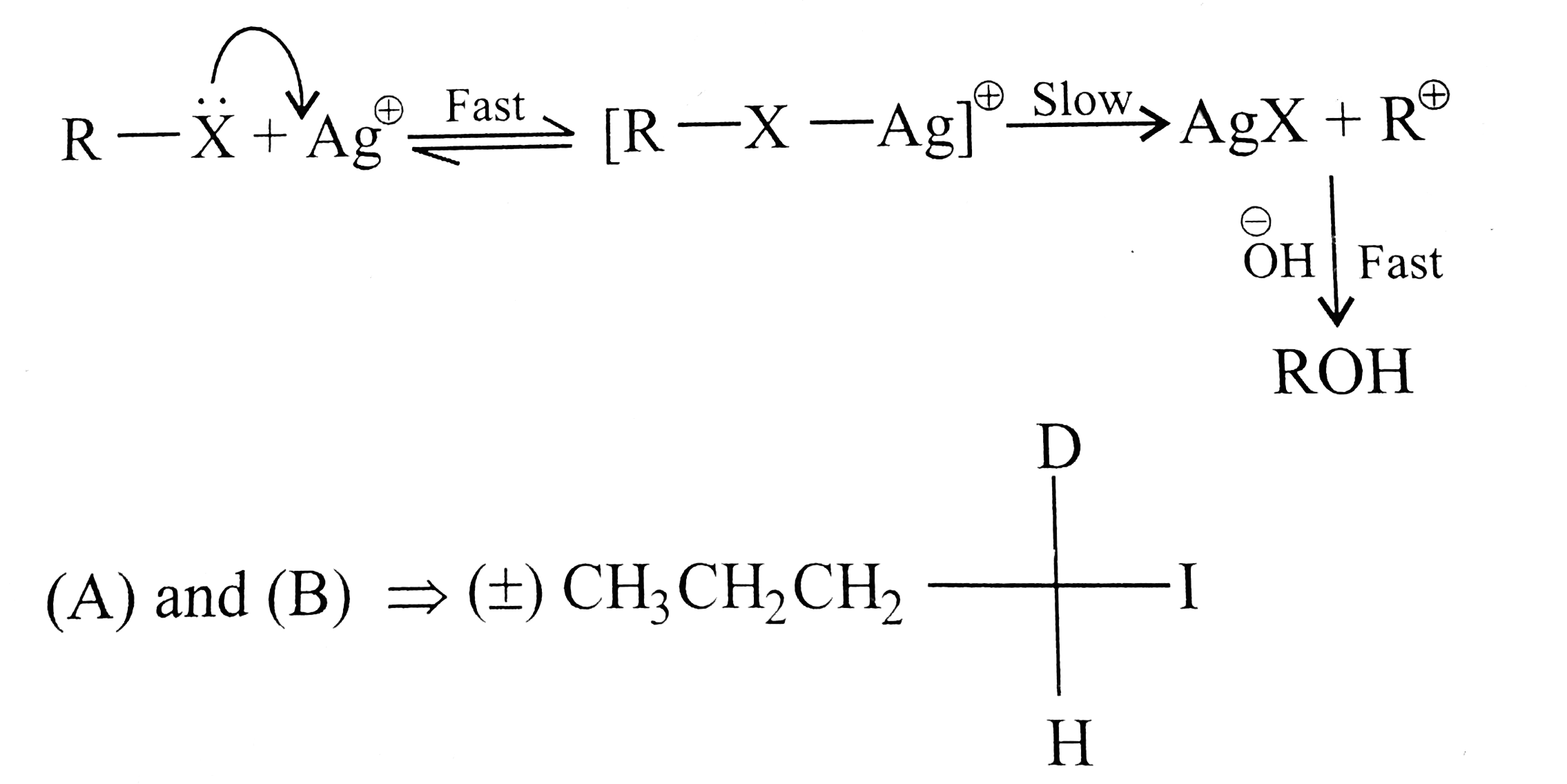
Half of the molecules are inverted and rest half are retained. So theproduct is (±).
When the mucleiphile and leaving groups are same, product is alwyas racemic, although the reaction proceeds via SN2 mechanism.
d. 1. (iv)>(III0>(ii)>(i), 2. (i)>(ii)>(iii)>(iv)>(v)
Alkyl group echances ionisation in the order Me>Eti−Pr>MNt−Bu (Hyperconjugation) Nitoro group retards ionisation, due to ¯e withdrawing effect of this group.
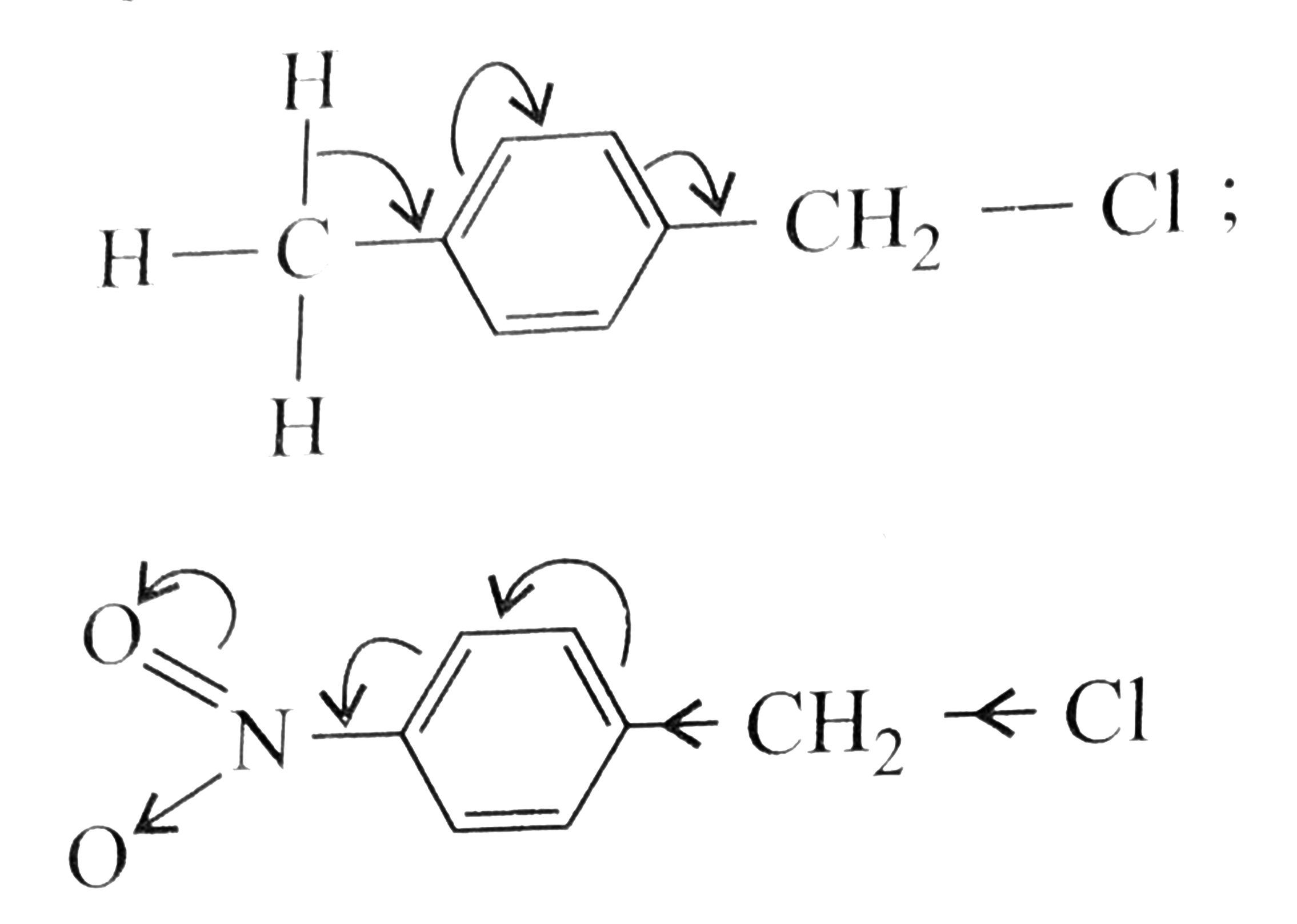
It is therefore clear that ¯e withdrawing group will favor SN−2 mechanism for a compound with an α− halogen atom. Such groups aare COOR,NO2,CN, etc.e.g., both ethyl −α− bromonpropionate (CH3−CH(Br)−COOC2H5) and diethuylbromomalonate
(C+2H5OOC−CH(Br)−COOC2H5) undergo hydroysis by SN2 mechanism.
On the other hand, COOᶱ ion has +I effect,m as due to its negative charge it ionises the α− halogen atom, Also δ charge on α−C atom opposes the approach of nucleophile.
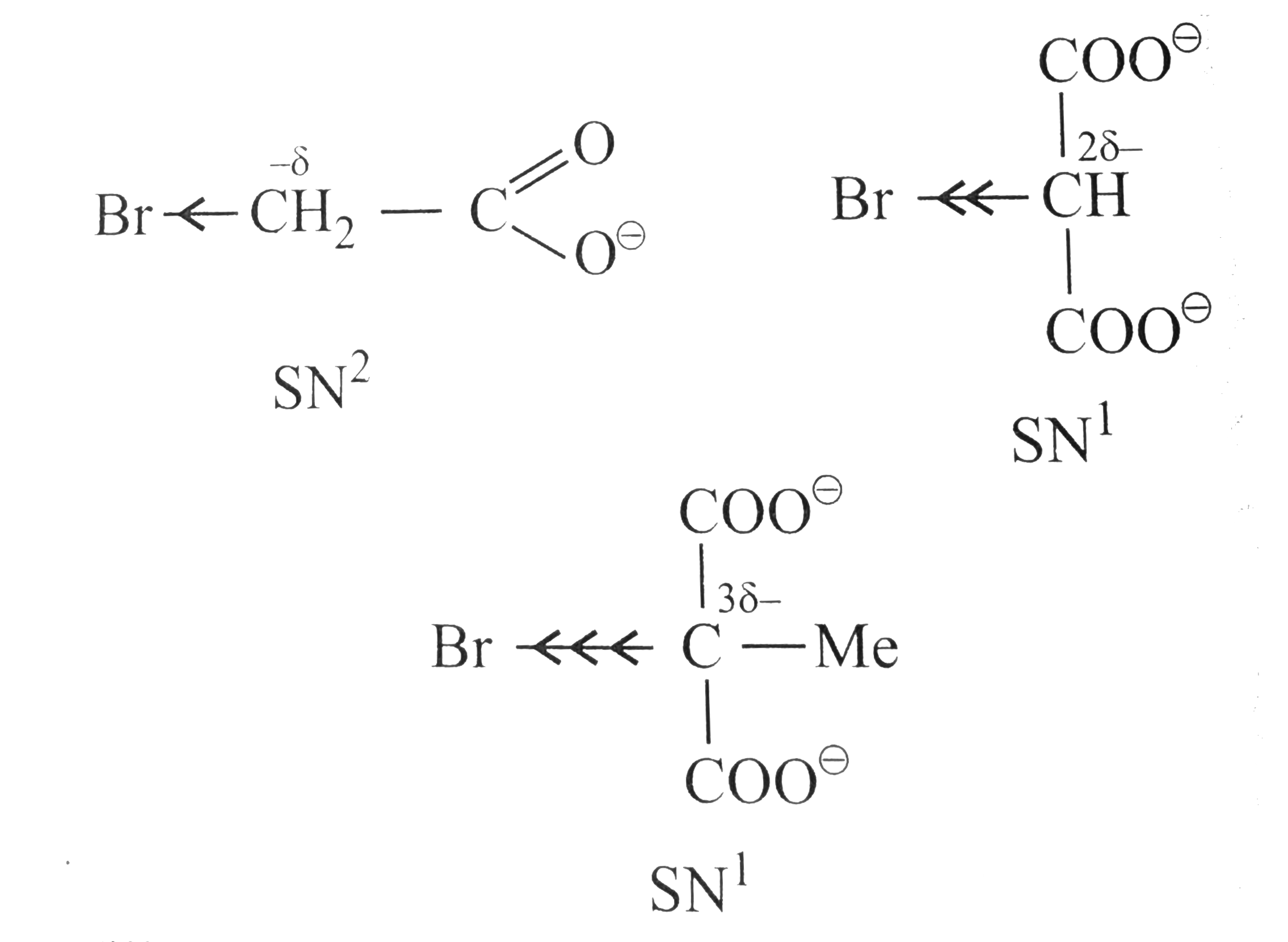
e. 1. (iii)>(ii)>(i) (Group leability is I−>Br>Cl−)
2. (vii)>(v)>(vi) (Steric factor makes the reactivity 1∘>2∘>3∘)
3. (vii)>(ix)>(viii)
(Viii) is 3∘ and the slowest),
(ix) suffers from β− substitution.
f. i. Optical purity of bromide =30∘36∘×100=83%
Optical purity of alcohol =−6.0∘−10.3×100=58%
ii. Percent inversion =58%83%×100%=70%
Percent racemisation =100%−70%=30%
iii. Inversin involves only backsildes and frontside attacks. The percentage of caksisde attack is the sum of th inversion. and one half the percetage of racemisation. The percentage of forntside attack is the remaining half of the percentage of racemission.
Percentage of backside attack =70%+12(30%)
Perctage of frontside attack =12(30%)=15%
g. 1. Cyvlopropyl chloride is less reactive than cyclopentyl chloride in each type of reaction becuase the sp2−C (120∘ bond angle) created in each T.S. increases the ring strain.
2. Vinyl hlaides are inert towards both SN−1 and SN2 reactions.
i. In SN−1 reactions they would have to ionise vinyl cations, which are very unstable because of their sp hybridiasation.
ii. The stronger (C−X) bond is difficult to break due to resonance stablisation. SO SN2 is not possible.

h. a. Acidic character: HF>H2O>NH3>CH4
Basic character : Fᶱ<OᶱH<NᶱH2<CᶱH3
Stronger the acid, weaker is its conjuagate base.
i. a. When teh nucleophilic centre is same. Nucleophilicity is same as basic character:
H3O⊕>CH3COOH>CH3OH>H2O
Basically and mucleophilicity:
H2O<CH3COOᶱ<CH3Oᶱ<ᶱOH
j. b. Weaker the base or stronger the acid, better is the leaving group,
Acidic character: C6H5SO3H>CH3COOH>C6H5OH>CH3OH
k. b. Acidic and leaving group order:
CF3SO3→MeSO3→AcO→MeO−.
Topper's Solved these Questions
- AROMATIC COMPOUNDS AND ALKYL AND ARYL HALIDES BOOK - CENGAGE CHEMISTRY ENGLISHCHAPTER - AROMATIC COMPOUNDS AND ALKYL AND ARYL HALIDES EXERCISE - Solved Examples
21 Videos
- AROMATIC COMPOUNDS AND ALKYL AND ARYL HALIDES BOOK - CENGAGE CHEMISTRY ENGLISHCHAPTER - AROMATIC COMPOUNDS AND ALKYL AND ARYL HALIDES EXERCISE - Solved Problems
37 Videos
- APPENDIX INORGANIC VOLUME 2BOOK - CENGAGE CHEMISTRY ENGLISHCHAPTER - APPENDIX INORGANIC VOLUME 2EXERCISE - Short Answer Type
179 Videos
- BIOMOLECULESBOOK - CENGAGE CHEMISTRY ENGLISHCHAPTER - BIOMOLECULESEXERCISE - Exercises Archives (Analytical And Descriptive)
8 Videos
Similar Questions
Benzene, touene, xylene (o,m,p) and mesitylene dissolve in HBF4 to from salts. Expalin the order of basicity:
Mesitylene >m−Xylene>o− and p− Xylenen gt Toulene gt Benzene
View SolutionComplete the following reactions:

View SolutionWhich metals are generally extracted by the electrolytic processes ? What positions these metals generally occupy in the periodic table?
View SolutionAlanine, the amino acid the respective structure at pH = 2 and pH = 10 will be
View Solution(CH_(3))_(3)C CH_(2)-CBr(CH_(3))_(2)overset(Heat)rarr The major product is
View SolutionWrite the structure of the major organic product in each of the following reactions:
(i) CH3CH2CH2Cl+NaIacetone−−−→heat
(ii) (CH3)3CBr+KOHethanol−−−→heat
(iii) CH3CH(Br)CH2CH3+NaOHwater−−→
(iv) CH3CH2Br+KCNaq. ethanol−−−−−→
(v) C6H5ONa+C2H5Cl→
(vi) CH3CH2CH2OH+SOCl2→
(vii) CH3CH2CH=CH2+HBrperoxide−−−−→
(viii) CH3CH=C(CH3)2+HBr→
View SolutionPredict the products of the following reactions:
(i) CH3−CH2−CH2−O−CH3+HBr→
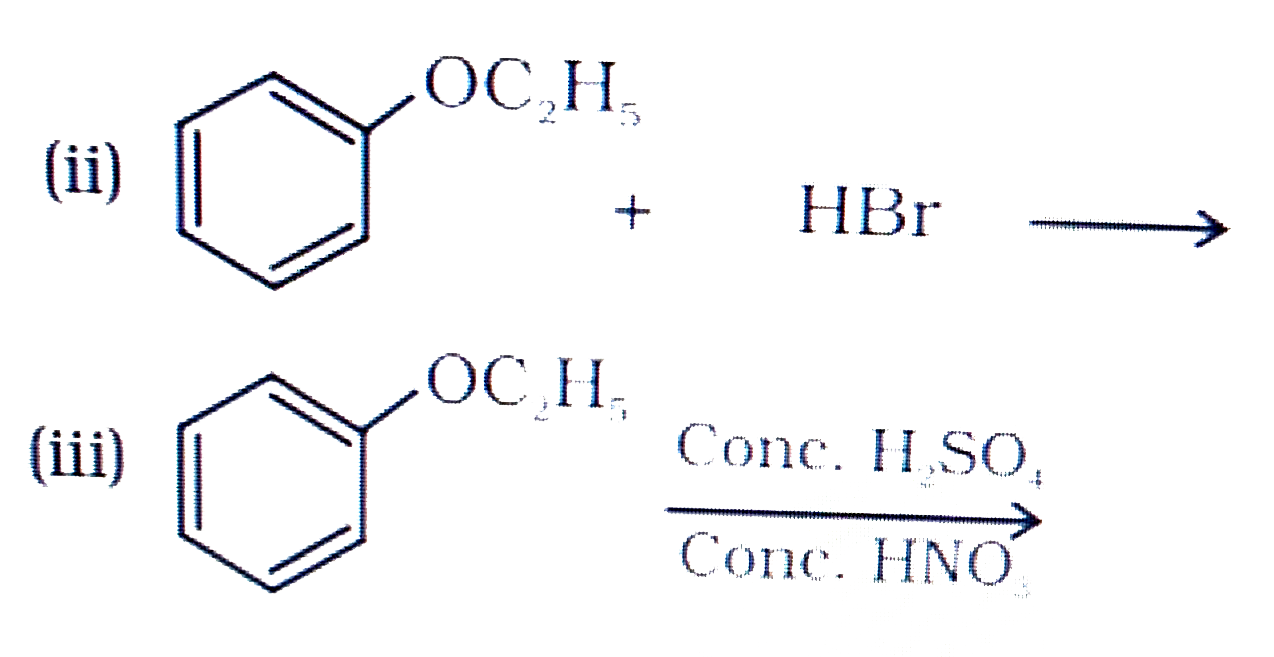
(iv) (CH3)3C−OC2H5HI−−→
View SolutionClassify the following reactions in one of the reaction type studied in this unit (i) CH_(3)CH_(2)Br+SH^(-) rarr CH_(3)CH_(2)SH+Br^(-) (ii) (CH_(3))_(2)C=CH_(2)+HCl rarr (CH_(3))_(2)C(Cl)CH_(3) (iii) (CH_(3))_(3)C CH_(2)OH+HBr rarr (CH_(3))_(2)CBrCH_(2)CH_(3) (iv) CH_(3)CH_(2)Br+HO^(-) rarr CH_(2)=CH_(2)+H_(2)O+Br^(-)
View SolutionMajor product of the given reaction is
CH3−CH3∣C∣CH3−CH∣CI−CH3C2H5O−−−−−−→
View SolutionHow many of the following alkyl halides would react by SN1 mechanism?
CH3Br,CH3CH2Br,CH3CH2CH2I,(CH3)3CBr,BrCH3CH=CH2,C6H5CH2Br,(CH3)3CCH2Br,C6H5CHBrCH3,CH3CH=CHCH2Cl.
 .
.
View SolutionThe reaction, (CH_(3))_(3)C-Br overset(H_(2)O)rarr (CH_(3))_(3)C-OH is
View SolutionClassify the following reactions in one of the reaction type studied in this unit. (a) CH_(3)CH_(2)Br +HS^(-) rarr CH_(3)CH_(2)SH + Br^(-) (b) (CH_(3))_(2)C = CH_(2) + HCl rarr (CH_(3))_(2)C Cl - CH_(3) (c) CH_(3)CH_(2)Br + HO^(-) rarr CH_(2) + H_(2)O + Br^(-) (d) (CH_(3))_(3)C-CH_(2)OH + HBr rarr (CH_(3))_(2)CBrCH_(2)CH_(3) + H_(2)O
View Solutionनिम्नलिखित अभिक्रियाओं को वर्गीकृत कीजिए ।
(क) CH3CH2Br+HS−→CH3CH2SH+Br−
(ख) (CH3)2C=CH2HCl→(CH3)2CCl−CH3
(ग)CH3CH2Br+HO−→CH2=CH2=CH2+H2O+Br+
(घ)(CH3)3C−CH2OH+HBr→(CH3)2CBrCH2CH3+H2O
View Solutionनिम्नलिखित अभिक्रियाओं के प्रमुख उत्पाद कि संरचना लिखिए -
(i) CH3CH2CH2Cl+NaIAcetone−−−−−−→Heat
(ii) (CH3)3CBr+KOHEthanol−−−−−−→Heat
(iii) CH3CH(Br)CH2CH3+NaOHWater−−−→
(iv) CH3CH2Br+KCNAq. ethanol−−−−−−→
(v)C6H5ONa+C2H5Cl→
(vi) CH3CH2CH2OH+SOCl2→
(vii) CH3CH2CH=CH2+HBrPeroxide−−−−→
(viii) CH3CH=C(CH3)2+HBr→
View SolutionCompound A in the following raction is
CH3−Cl+A→CH3−CH2−COOCH3H3O+ −−−−→CH3−CH2−COOH+CH3−OH
View SolutionCH_(3)-CH_(2)-O-underset(CH_(3))underset(|)(C)=CH_(2)overset(H_(3)O^(oplus))rarr Products are
View Solution
